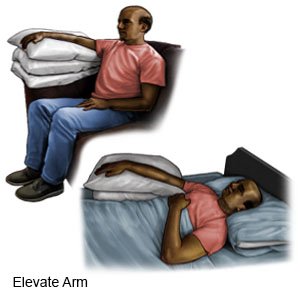Arteriovenous Graft Creation for Hemodialysis
Medically reviewed by Drugs.com. Last updated on Aug 4, 2025.
You may have mild bruising or swelling near your surgery area. The area may drain a few drops of blood or pink fluid for 24 hours. Your AVG will take 2 to 3 weeks to heal. After this time, it can be used for hemodialysis.
DISCHARGE INSTRUCTIONS:
Call your local emergency number (911 in the US) if:
- You feel lightheaded, short of breath, and have chest pain.
- You cough up blood.
- You have trouble breathing.
- You cannot stop the bleeding from the surgery area even after you hold firm pressure for 10 minutes.
Seek care immediately if:
- Blood soaks through your bandage.
- Your arm, hand, or fingers are cold, numb, blue, or pale.
- Your bruise suddenly gets bigger.
- You have trouble moving your arm or hand.
- Your arm or leg feels warm, tender, and painful. It may look swollen and red.
Call your doctor or hematologist if:
- You have a fever or chills.
- Your surgery area is red, swollen, or draining pus.
- You have nausea or are vomiting.
- Your skin is itchy, swollen, or you have a rash.
- You cannot feel a thrill over your AVG.
- You have questions or concerns about your condition or care.
Medicines:
You may need any of the following:
- Prescription pain medicine may be given. Ask your healthcare provider how to take this medicine safely. Some prescription pain medicines contain acetaminophen. Do not take other medicines that contain acetaminophen without talking to your healthcare provider. Too much acetaminophen may cause liver damage. Prescription pain medicine may cause constipation. Ask your healthcare provider how to prevent or treat constipation.
- Acetaminophen decreases pain and fever. It is available without a doctor's order. Ask how much to take and how often to take it. Follow directions. Read the labels of all other medicines you are using to see if they also contain acetaminophen, or ask your doctor or pharmacist. Acetaminophen can cause liver damage if not taken correctly.
- Take your medicine as directed. Contact your healthcare provider if you think your medicine is not helping or if you have side effects. Tell your provider if you are allergic to any medicine. Keep a list of the medicines, vitamins, and herbs you take. Include the amounts, and when and why you take them. Bring the list or the pill bottles to follow-up visits. Carry your medicine list with you in case of an emergency.
Care for your surgery area as directed:
Remove your bandage in 48 hours or as directed. Carefully wash around the area with soap and water. Dry the area and put on new, clean bandages as directed. Change your bandages when they get wet or dirty.
If you have bleeding from the surgery area,
apply firm, steady pressure to stop the bleeding. Apply pressure with a clean gauze or towel for 5 to 10 minutes. Call 911 if bleeding becomes heavy or does not stop.
Activity guidelines for your arm with the AVF:
- Do not lift anything heavier than 5 pounds for 48 hours or as directed.
- Do not push or pull with your arm.
- Do not sleep with your arm tucked under you.
- Do not carry a purse or bags with your arm.
- Do not wear tight-fitting clothing or jewelry over your arm or hand.
- After 48 hours, do gentle arm exercises as directed. These exercises will help your AVF heal.
Feel for a thrill over your AVG:
Your healthcare provider will tell you how often to feel for a thrill. Place your index finger and second finger over the surgery area. You should feel a vibration.
Apply ice
on the surgery area for 15 to 20 minutes every hour, or as directed. Use an ice pack, or put crushed ice in a plastic bag. Cover the bag with a towel before you apply it to your skin. Ice helps prevent tissue damage and decreases swelling and pain.
Elevate your arm
above the level of your heart as often as you can. This will help decrease swelling and pain. Prop your arm on pillows or blankets to keep it elevated comfortably.
 |
Tell healthcare providers that you have an AVG:
Tell them not to do IVs, blood draws, and blood pressure readings in your arm with the AVG. Do not get injections in your arm with your AVG. These actions can help prevent infection, bleeding, or damage to your AVG.
Follow up with your doctor or surgeon as directed:
Write down your questions so you remember to ask them during your visits.
© Copyright Merative 2025 Information is for End User's use only and may not be sold, redistributed or otherwise used for commercial purposes.
The above information is an educational aid only. It is not intended as medical advice for individual conditions or treatments. Talk to your doctor, nurse or pharmacist before following any medical regimen to see if it is safe and effective for you.
Learn more about Arteriovenous Graft Creation for Hemodialysis
Treatment options
Care guides
Further information
Always consult your healthcare provider to ensure the information displayed on this page applies to your personal circumstances.
